|
|
|||||||||||||||||||||||||
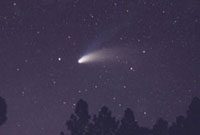 |
|||||||||||||||||||||||||
| Comet Hale-Bopp (official designation: C/1995 O1) was discovered on July 23, 1995 by Alan Hale, the founder and Director of the Southwest Institute for Space Research, and independently by Thomas Bopp, an amateur astronomer from Glendale, Arizona. | |||||||||||||||||||||||||
| Click on image for a larger view. | |||||||||||||||||||||||||
| At the time of its discovery the comet was a dim and unimpressive object not dramatically different in appearance from the dozen or more comets that are discovered every year, however orbital calculations soon revealed that Hale-Bopp was at the enormous distance of 7.15 Astronomical Units (665 million miles, or 1.1 billion km) from the sun. Furthermore, these calculations also showed that the comet was over a year and a half away from its closest approaches to the sun and earth, at which time it had the potential of providing a brilliant celestial display.
The comet became visible to the naked eye by the middle of 1996, and steadily brightened as the rest of the year progressed. By early 1997 it had become a spectacular object in the nighttime sky and starting to receive attention from around the world. It was closest to the earth on March 22, 1997, at 1.32 Astronomical Units (122 million miles, or 197 million km) and nearest the sun on April 1, 1997, at 0.91 Astronomical Units (85 million miles, or 137 million km). Around that time it was as bright as the brightest stars in the sky, and became one of the brightest comets to appear during the 20th Century. Its high brightness, long duration of visibility, and convenient location in the evening sky after dusk made Hale-Bopp the most widely-observed comet in history. In addition to being followed so eagerly by the general public, Hale-Bopp was also an immensely rewarding object scientifically. Study of the comet has already revealed incredible amounts of new information about the physical and chemial processes going on within comets and about the formation of the planets in our solar system, including Earth. Scientists will be kept busy analyzing data from the comet for many years yet to come. |
|||||||||||||||||||||||||
| Comet Hale-Bopp remained visible as a very dim object in larger backyard telescopes located in the southern hemisphere until the latter months of 2000. It continues to be observed with larger observatory telescopes, as evidenced by the below images taken with the European Southern Observatory's 2.2-meter telescope in La Silla, Chile, in late February and early March 2001. Earthbound telescopes such as this and space-based instruments like the Hubble Space Telescope should be able to follow Comet Hale-Bopp for perhaps another one or two decades. Once it fades completely out of sight we will have to wait until it makes its next return, which according to the latest calculations will be approximately 2,390 years from now. | |||||||||||||||||||||||||
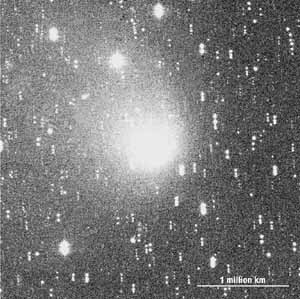 |
|||||||||||||||||||||||||
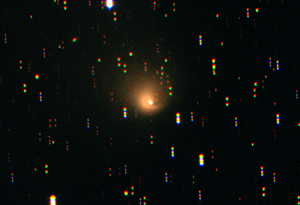 |
|||||||||||||||||||||||||
| Wide-field (above) and enhanced close-up (right) image of Comet Hale-Bopp, taken during the interval February 27 -- March 2, 2001. Both images copyright European Southern Observatory. | |||||||||||||||||||||||||
| NOTE ADDED APRIL 2004: Below are two of the most recent images of Comet Hale-Bopp that I am aware of: | |||||||||||||||||||||||||
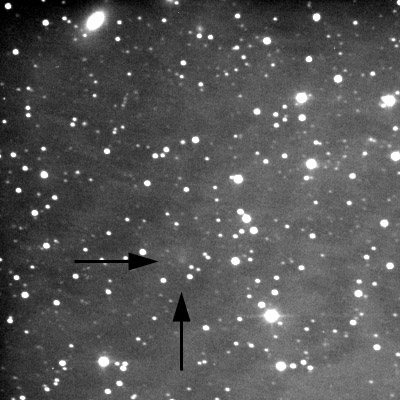 |
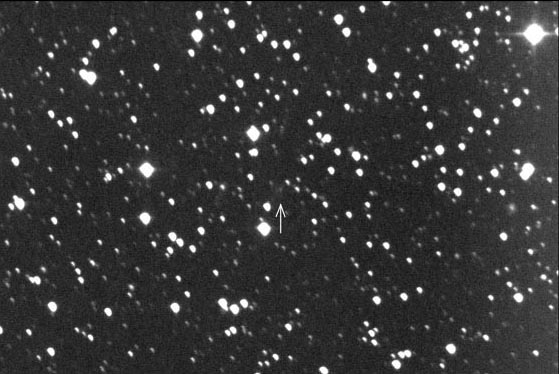 |
||||||||||||||||||||||||
| LEFT: Image taken by Australian astronomer Gordon Garradd, from Loomberah, New South Wales, on December 25, 2003. RIGHT: Image taken by Japanese astronomer Mitsunori Tsumura, from a site in Western Australia, on March 25, 2004. At the time this image was taken the comet was 19.4 AU from the sun, slightly beyond the orbit of Uranus. | |||||||||||||||||||||||||
| THE NEWEST IMAGE: This is one of several images of Comet Hale-Bopp taken by Andrew Rivkin and Richard Binzel of MIT, using the 6.5-meter Clay Telescope at the Magellan Observatory in Las Campanas, Chile on January 8, 2005. The comet was located 20.9 AU from the sun (almost 2 AU beyond the orbit of Uranus) and 21.2 AU from the earth; but despite this enormous distance, the comet still shows a distinct tail. | |||||||||||||||||||||||||
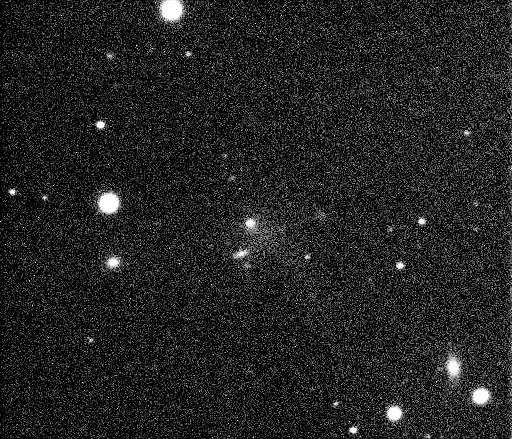 |
|||||||||||||||||||||||||
| LATEST IMAGE: This image was taken from Western Australia on January 29, 2006, by Japanese amateur astronomer Mitsunori Tsumura. At that time Hale-Bopp was located 22.8 AU from the sun and 23.1 AU from Earth. | 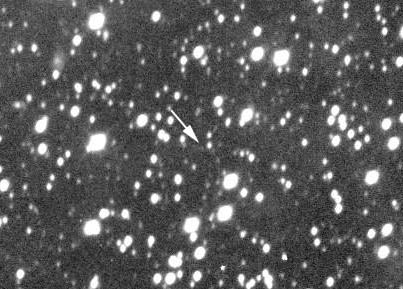 |
||||||||||||||||||||||||
| LINKS TO SOME COMET PAGES
Southwest Institute's images page for comets and near-Earth asteroids Southwest Institute's recent comets page, which contains information and images of several recent bright comets The Central Bureau for Astronomical Telegrams (world clearinghouse for reporting and announcing discoveries) Comet discoveries made by the Solar and Heliospheric Observatory (SOHO) spacecraft The Stardust project (mission to collect comet samples) The Deep Impact mission (analyzing a comet's subsurface material) Images of Comet Borrelly from the Deep Space 1 encounter in September 2001 European Space Agency's Rosetta mission (long-term study of a comet) |
|||||||||||||||||||||||||
| BACK TO MAIN PAGE | |||||||||||||||||||||||||